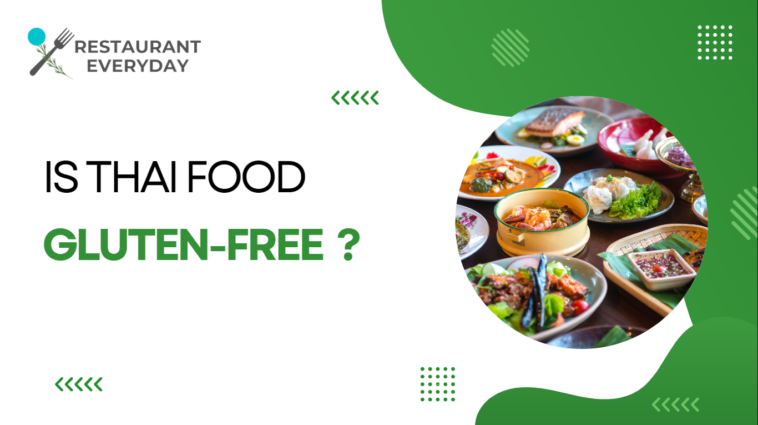Amidst the rising health trends, Is Thai food gluten-free tops the list. Thai cuisine is renowned for its vibrant flavors, aromatic spices, and diverse range of dishes. As the popularity of gluten-free diets continues to soar, many individuals with gluten sensitivities or celiac disease wonder if Thai food can be part of their culinary repertoire. In this article, we’ll delve into the gluten-free nature of Thai cuisine, examine common Thai food ingredients, explore gluten-free Thai dishes, and identify what Thai foods may contain gluten.
Is Thai Food Gluten-Free : An Analysis
Gluten is a protein found in wheat, barley, and rye. For individuals with celiac disease or gluten sensitivity, the consumption of gluten can lead to various health issues, including digestive discomfort and damage to the small intestine. Therefore, adopting a gluten-free diet becomes essential for managing these conditions.
Gluten-free diets emphasize the exclusion of gluten-containing grains and products derived from them. Instead, individuals focus on alternatives like rice, corn, quinoa, and gluten-free flours. This dietary approach extends beyond simply avoiding bread and pasta, requiring a thorough examination of all ingredients to ensure they do not contain hidden sources of gluten.
Thai food, with its diverse array of flavors and ingredients, holds promise for those seeking gluten-free options. The foundation of Thai meals often relies on rice, rice noodles, and rice flour, making many traditional dishes inherently gluten-free. Moreover, fresh herbs, spices, meats, seafood, vegetables, and fruits are staples in Thai cooking, contributing to a naturally gluten-free palette.
However, it’s crucial to be cautious and discerning, as some elements of Thai cuisine may harbor gluten. Common sources of gluten in Thai food include soy sauce, which is traditionally made with wheat, and oyster sauce, which may contain gluten-based thickeners. Additionally, certain types of noodles, often made from wheat flour, can pose a gluten-related challenge.
In essence, while Thai cuisine provides a promising terrain for gluten-free dining, a discerning eye and an awareness of specific ingredients are necessary. The richness and complexity of Thai flavors can be enjoyed with confidence by individuals adhering to a gluten-free diet, provided they make informed choices and communicate their dietary needs effectively when dining out.
Common Thai Food Ingredients
Thai cooking relies on a bundle of ingredients, many of which are naturally gluten-free. This section aims to identify these gluten-free components, providing a foundation for gluten-conscious culinary exploration.
Rice and Rice-Based Products
- Central role of rice as a staple in Thai cuisine.
- Varieties of rice used, such as jasmine rice and glutinous rice.
- Common rice-based products like rice noodles and rice flour.
Fresh Herbs and Spices
- Diverse array of fresh herbs, including cilantro, basil, and mint.
- Signature Thai spices such as lemongrass, galangal, and kaffir lime leaves.
- Contribution to the distinct and aromatic flavors of Thai dishes.
Meat and Seafood
- Wide use of proteins, including chicken, beef, pork, and seafood.
- Common cooking methods such as grilling, stir-frying, and currying.
- Presence of dishes like Pad Kra Pao (stir-fried basil chicken) and Tom Yum Goong (spicy shrimp soup).
Vegetables and Fruits
- Abundance of vegetables like Thai eggplant, bamboo shoots, and bean sprouts.
- Incorporation of tropical fruits like mango, pineapple, and papaya.
- Use in salads, curries, and as accompaniments to main courses.
Coconut Milk
- Essential ingredient in Thai curries and desserts.
- Contribution to creamy and rich textures in dishes like Green Curry and Sticky Rice with Mango.
Fish Sauce
- Ubiquitous condiment in Thai cooking for its umami and salty flavor.
- Inclusion in various sauces, marinades, and dressings.
Tamarind Paste
- Souring agent in Thai cuisine.
- Featured in dishes like Pad Thai for its distinctive tangy taste.
Palm Sugar
- Sweetener derived from palm trees.
- Use in balancing flavors in Thai desserts and certain savory dishes.
Lime
- Commonly used for its citrusy freshness.
- Squeezed over dishes like Som Tum (green papaya salad) and served as a garnish.
Chilies
- Integral for adding heat to Thai dishes.
- Varying types of chilies used, from mild to extremely spicy.
Which Thai Dishes are Gluten-Free?
For those seeking gluten-free options in Thai cuisine, the good news is that there are numerous delectable choices. From appetizers like fresh spring rolls to main courses like green curry with chicken, pad Thai with rice noodles, and grilled fish with herbs, Thai cuisine offers a variety of gluten-free delights.
Green Curry with Chicken
- Fragrant green curry paste made with herbs and spices.
- Coconut milk for a creamy texture.
- Served with chicken and a variety of vegetables over rice.
Pad Thai with Rice Noodles
- Stir-fried rice noodles with shrimp, chicken, or tofu.
- Tamarind paste for a tangy flavor.
- Garnished with peanuts, bean sprouts, and lime.
Tom Yum Soup
- A hot and sour soup made with a broth infused with lemongrass, galangal, and kaffir lime leaves.
- Typically includes shrimp, mushrooms, and other herbs.
- A refreshing and gluten-free option.
Grilled Fish with Herbs
- Fresh fish marinated in a mixture of Thai herbs and spices.
- Grilled to perfection and served with a side of gluten-free dipping sauce.
- Light, flavorful, and free from gluten-containing ingredients.
Sticky Rice with Mango (Khao Niew Mamuang)
- A classic Thai dessert featuring sweet sticky rice.
- Topped with ripe mango slices and drizzled with coconut milk.
- A delightful gluten-free treat to satisfy your sweet tooth.
Chicken Satay
- Skewers of marinated and grilled chicken.
- Served with a gluten-free peanut sauce.
- A popular appetizer or snack option.
Som Tum (Green Papaya Salad)
- Shredded green papaya mixed with tomatoes, green beans, peanuts, and chili.
- Dressed with a lime and fish sauce-based dressing.
- A zesty and gluten-free Thai salad.
Tom Kha Gai (Coconut Chicken Soup)
- A coconut milk-based soup with chicken, mushrooms, and Thai herbs.
- Creamy and flavorful without the use of gluten-containing ingredients.
Miang Kham
- Bite-sized parcels filled with a mixture of coconut, peanuts, lime, ginger, and chili.
- Often wrapped in leaves for a unique and gluten-free appetizer.
Massaman Curry
- A rich and flavorful curry with beef or chicken.
- Features potatoes, peanuts, and a fragrant blend of spices.
- Typically served over rice.
What Thai Food is Not Gluten-Free?
While Thai cuisine offers naturally gluten-free options, it’s essential to be aware of certain dishes and ingredients that may contain gluten.
- One notable culprit is soy sauce, a common seasoning in Thai cooking that traditionally includes wheat.
- Oyster sauce is another potential source of gluten, as it often contains wheat-based thickeners.
- Additionally, certain types of noodles, particularly those made from wheat flour, pose a risk for individuals following a gluten-free diet.
- Fried dishes with batter may also contain gluten, as the batter often incorporates wheat flour. Furthermore, some curries and stews may use ingredients that contain gluten, emphasizing the importance of scrutinizing the components of these dishes.
Overall, while there are numerous gluten-free Thai options, individuals with gluten sensitivities should exercise caution, inquire about ingredients when dining out, and make informed choices to ensure a safe and enjoyable culinary experience.
Tips for Gluten-Free Dining in Thai Restaurants
- Effective communication is paramount when dining at Thai restaurants with a gluten-free diet. Clearly expressing your dietary needs to the server or chef is the first step to ensure a safe dining experience. Take the opportunity to inquire about specific ingredients in dishes and request gluten-free alternatives.
- Customizing orders is another key strategy for gluten-free dining. Choose dishes that are naturally gluten-free or can be easily modified to meet your dietary requirements. When ordering stir-fries or noodle dishes, ask for gluten-free soy sauce or tamari as a substitute. This simple adjustment can significantly enhance the gluten-free compatibility of your chosen dishes and justify the restaurant service charges that you are paying in your bill.
- Inquire about kitchen practices to prevent cross-contact with gluten-containing items. Ensure that utensils and cooking surfaces are thoroughly cleaned before the preparation of gluten-free dishes to mitigate the risk of unintentional exposure.
- Familiarize yourself with common gluten-containing ingredients in Thai cuisine to make informed choices. Be aware of hidden sources of gluten in sauces, marinades, and thickeners. This knowledge empowers you to navigate menus with greater confidence, minimizing the risk of inadvertently consuming gluten.
- Opt for naturally gluten-free options when exploring the menu. Grilled meats, seafood, and salads are excellent choices that typically align with gluten-free requirements. Embrace rice-based dishes, such as curries with rice or rice noodle options, to enjoy the diverse flavors of Thai cuisine without compromising your dietary needs.
- Consider using gluten-free translation cards in the local language to communicate your dietary restrictions effectively. These cards can help convey your needs to the restaurant staff and ensure a clear understanding of your gluten-free requirements.
Thus, stay informed about local culinary practices to navigate menus more effectively. Seek recommendations from locals or online communities regarding gluten-free dining options. By following these tips, individuals with gluten sensitivities can confidently enjoy the rich and diverse flavors of Thai cuisine while minimizing the risk of gluten exposure. In contrast if the restaurant mismanages your order you can sue the restaurant.
Conclusion: A guide for Gluten-free Thai Dining
In conclusion, Thai cuisine offers a rich tapestry of gluten-free options, making it accessible to those with gluten sensitivities. By understanding common Thai ingredients and dishes, individuals can confidently explore and savor the diverse flavors of Thai cuisine. With mindful dining practices and effective communication with restaurant staff, enjoying gluten-free Thai food becomes an exciting and delicious culinary adventure. So, go ahead and embark on a journey of gluten-free exploration in the world of Thai flavors!
Read more about Thai restaurants in your vicinity here : Thai Cuisine Restaurants




